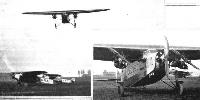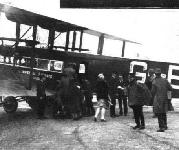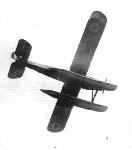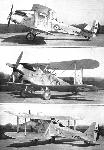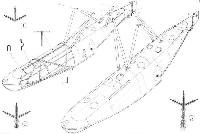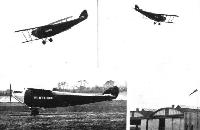Фотографии
-
THE SPANISH FLIGHT TO MANILA: Our first picture shows Capt. Estevez (left), leader of the Madrid-Manila flight, and his mechanic Calvo, who were lost in the desert near Amman for seven days before being found by a R.A.F. pilot. The second picture shows one of the three Breguet IX machines filling up with "Shell" at Madrid prior to the start on April 5.
Самолёты на фотографии: Breguet Br.19 - Франция - 1922
-
Регистрационный номер: H-NADG THE STRANGER WITHIN OUR GATES: Two views of the three-engined Fokker monoplane recently delivered to Martlesham Heath. It was on a similar machine that Commander Byrd reached the North Pole. The engines of above machine are, however, Armstrong-Siddeley "Lynx" radials. On arrival at Martlesham, Mijnheer Grase, the Fokker chief test pilot, is reported to have looped the machine
Самолёты на фотографии: Fokker F.VII / C-2 / F.XIV - Нидерланды - 1924
-
CROYDON DURING THE STRIKE: The general strike resulted in a vast increase in the air traffic between Croydon and the Continent and a great number of extra machines were called into service. Shown a line-up of machines, among which may be recognised two Farman "Goliaths," a Spad, and two Handley-Page W.10's.
Самолёты на фотографии: Bleriot-SPAD S.33 / S.46 / S.50 / S.56 / S.66 - Франция - 1920Farman F.60 Goliath / F.169 - Франция - 1918Handley Page H.P.18 (W.8) / H.P.30 (W.10) - Великобритания - 1919
-
CROYDON DURING THE STRIKE: The general strike resulted in a vast increase in the air traffic between Croydon and the Continent and a great number of extra machines were called into service. Shown passengers emplaning in a W.10
Самолёты на фотографии: Handley Page H.P.18 (W.8) / H.P.30 (W.10) - Великобритания - 1919
-
CROYDON DURING THE STRIKE: The general strike resulted in a vast increase in the air traffic between Croydon and the Continent and a great number of extra machines were called into service. Shown a quantity of luggage being loaded for Paris.
Самолёты на фотографии: Handley Page H.P.18 (W.8) / H.P.30 (W.10) - Великобритания - 1919
-
AN "EELS-EYE VIEW" OF THE D.H.50 SEAPLANE: In this photograph the shape of the Duralumin floats may be seen. Note the rounded bows and sharp heels.
Самолёты на фотографии: De Havilland D.H.50 - Великобритания - 1923
-
THE HARROVIAN: One of the De Havilland "Moths," with "Cirrus" engine, flying over Harrow-on-the-Hill, piloted by Captain Hubert Broad.
Самолёты на фотографии: De Havilland Moth / D.H.60 - Великобритания - 1925
-
Германия после Первой мировой войны, несмотря на запрет, продолжала разрабатывать истребители, примером чему являлся L.65. Эти разработки помогли ей в 1930-е годы быстро возродить свою истребительную авиацию.
A Lithuanian Biplane: The first aeroplane to be constructed in Lithuania, by Linenau and Co. Fitted with a Napier "Lion" engine it is stated to have a speed of 160 m.p.h. and to have reached an altitude of 17,000 ft. in 17 minutes.Самолёты на фотографии: Albatros L.65 / AFG Memel 1 - Германия - 1925
-
Регистрационный номер: N207 [3] THE BLACKBURN "SPRAT": This front view shows the divided undercarriage, for which a float chassis can be substituted.
Самолёты на фотографии: Blackburn Sprat / T.R.1 - Великобритания - 1926
-
Регистрационный номер: N207 [3] The Blackburn "Sprat" landing at Brough after a test flight.
Самолёты на фотографии: Blackburn Sprat / T.R.1 - Великобритания - 1926
-
Регистрационный номер: N207 [3] THE BLACKBURN "SPRAT," three views of which are shown, is a training machine convertible into a landplane or seaplane. The engine fitted as standard is a Rolls-Royce "Falcon" of 275 h.p.
Самолёты на фотографии: Blackburn Sprat / T.R.1 - Великобритания - 1926
-
THE BLACKBURN "SPRAT": In order to accommodate pilots of different height, the foot bars are made adjustable, the means of adjustment being such that the cables are always maintained at an even tension. On the right a sketch showing a typical cowling clip with locking device.
Самолёты на фотографии: Blackburn Sprat / T.R.1 - Великобритания - 1926
-
THE BLACKBURN "SPRAT": Some constructional details. The main sketch shows the two Duralumin floats, with their struts. The 12 inspection holes in each float have their covers riveted on. The transverse tubes through the floats serve to accommodate the beaching chassis, to which a jack action is given by levers (not shown) held in position by catches, of which that on the starboard float is shown. The float framework is also illustrated, with sections of certain main members. At 1, is shown the joint of the keelson to keel and planking near the bows, while 2 illustrates the same joint some distance aft of the step, and 3 the joint, with steel shoe on keel, immediately aft of the step. Note that water rudders are fitted in order to give good manoeuvrability on the water.
Самолёты на фотографии: Blackburn Sprat / T.R.1 - Великобритания - 1926
-
Blackburn "Sprat" 270 hp. Rolls-Royce "Falcon" Engine
Самолёты на фотографии: Blackburn Sprat / T.R.1 - Великобритания - 1926
-
"F.F.V.": A Vickers "Virginia" surveys Central London during the Great Strike.
Vickers "Virginia" (Two Napier "Lions") It is now six years since the late Sir John Alcock and Sir Arthur Whitten Brown flew across the Atlantic in a Vickers "Vimy" with two Rolls-Royce "Eagle" engines, a type similar to that on which the late Sir Ross Smith, and his brother, Sir Keith Smith, flew from London to Australia. The "Vimy" may be said to have been the prototype of the Vickers "Virginia" four-seater long-distance bomber which will take part in the Display. The "Virginia" is, however, fitted with more powerful engines (Napier "Lions"). The "Virginia" forms the standard equipment of Bombing Squadrons No.7, Bircham Newton, 9 (Manston), and 58 (Worthy Down).Самолёты на фотографии: Vickers Virginia - Великобритания - 1922
-
The Daimler L.20 on which the flight over the Alps was accomplished. The engine is a Mercedes-Daimler of 19 h.p. only.
Самолёты на фотографии: Daimler L 20 - Германия - 1924
-
OVER THE ALPS IN A 19 H.P. TWO-SEATER: These photographs give an excellent idea of the difficult country over which the little Daimler L.20 had to fly. In 1, the machine it seen approaching the Zeller See. 2 shows, on the left the Hohe Docke and, in the back-ground, the Glocknerin. The tip of the tail plane may just be seen on the right of the picture. The Hohe Tauern mountain chain is seen in 3, while 4 shows the two aviators, Dr. von Langsdorff (left) and Herr Guritzer the pilot, on their return to Sindelfingen.
Самолёты на фотографии: Daimler L 20 - Германия - 1924
-
Регистрационный номер: D-818 ON THE ZELLER SEE: After a successful landing on the ice.
Самолёты на фотографии: Daimler L 20 - Германия - 1924
-
TRANSPORT BY ROAD: This photograph shows how the Daimler L.20 is towed by a motor car, the wings being dismantled and hung on the sides of the fuselage.
Самолёты на фотографии: Daimler L 20 - Германия - 1924
-
Not very inviting in case of forced landings. Looking out over the port wing at the Hohe Tauern mountains.
Самолёты на фотографии: Daimler L 20 - Германия - 1924
-
COMMERCIAL MACHINE FOR AUSTRALIA: The A.N.E.C. III taking off for a flight at Brooklands aerodrome. Inset, two views of the machine in flight. Note the very small rudder.
Самолёты на фотографии: ANEC III - Великобритания - 1926
-
THE "STINSON-DETROITER": Front view showing the 200-h.p. Wright "Whirlwind" engine and the split-axle type landing gear which is provided with brakes on the wheels.
Самолёты на фотографии: Stinson SB-1 Detroiter - США - 1926
-
THE "STINSON-DETROITER": The landing gear, the wheels of which are fitted with brakes and non-skid chains.
Самолёты на фотографии: Stinson SB-1 Detroiter - США - 1926
-
THE "STINSON-DETROITER": A new American commercial cabin machine designed by Edie Stinson, a well-known American pilot. It is a four-seater and is fitted with brakes on the landing wheels.
Самолёты на фотографии: Stinson SB-1 Detroiter - США - 1926
-
THE "STINSON-DETROITER": The interior of the comfortable cabin.
Самолёты на фотографии: Stinson SB-1 Detroiter - США - 1926
Статьи
- Flight

